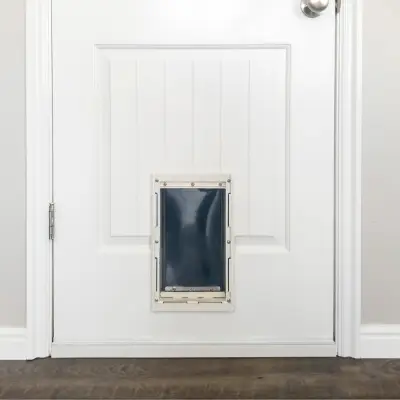Whether you want to add a new doggy door, replace an old one, or are looking at installing hollow interior doors for your pets, Mr. Handyman is here to help! Call our fully insured and highly qualified professionals to get your installation done.
Whether you want to add a new doggy door, replace an old one, or are looking at installing hollow interior doors for your pets, Mr. Handyman is here to help! Call our fully insured and highly qualified professionals to get your installation done.

Pets come in all shapes and sizes, so pet doors need to as well. Choosing the right size and placement is overwhelming as a Do-It-Yourself project, but the experienced professionals at Mr. Handyman will help you find the perfect fit for your home and pet.
To pick the right one for your pet, we start by taking your pet’s size into consideration. Obviously, a door built for a housecat is going to be much smaller than one built for an Irish Wolfhound.
Next, we take into consideration which type of door you are looking to install. There are a variety of door types, and each comes with its own set of pros and cons. We’ll work with you to determine which type best suits you and your pet’s needs.
Finally, we’ll help you determine how and where to place your pet door. Installing something as large as a pet door requires a certain level of construction knowledge and expertise. You don’t want to put a hole in your house or door until you’re sure it’s exactly right! Our experts will determine the best place to install your pet door based on the design of your home, the size, and style of the door, and where you would like the door to lead.
Pet doors come in a variety of materials, including glass, fiberglass, wood, and metal—we’ll help you determine which material would work best for you and your pet.
The mechanics of your pet door is another factor to consider. Pet doors can either be traditional flap doors, open electronically, or installed as patio sliders or French doors. We’ll help you choose the right type, which will depend on factors like price, size of the door, and aesthetic requirements.
Before attempting to DIY your pet door installation, consider whether you have the knowledge, skills, and tools needed to successfully complete the job. The last thing you need is a gaping hole in a door or your home that’s an open invitation for rodents and pests to enter.
Hiring professional pet door installers is cheaper and easier in the long run since they bring with them the tools, knowledge, and experience necessary to complete this complicated project.
Our skilled and knowledgeable service professionals are just the team you want to complete projects such as these within your home. With nearly 200 locations across the United States and Canada, you can find a Mr. Handyman near you!
Additionally, all our projects come with the Neighborly Done Right Promise™. If a job’s not done right, then we’ll make it right. To install your new pet door, contact us now!
All Mr. Handyman franchises are locally owned and operated and may offer fewer or more services than those listed here. To learn more about the pet door service offered in your area, contact your local Mr. Handyman for details or a customized on-site assessment.
Mr. Handyman has been helping homeowners repair, maintain, and enhance their spaces for over 25 years! We are the one-stop solution for everything on your to-do list and all your questions about home repairs, maintenance, and improvements. Here are answers to some of your most frequently asked questions about pet door installation services.
Ranking number one on the list of disadvantages of installing a doggy door sits security concerns. Especially larger doggy doors can allow intruders and unwanted visitors like wildlife and stray animals to enter your home.
Additional concerns of installing doggie doors include:
A dog door can be added to almost any interior or exterior door..
You can even install a pet screen door to replace a standard screen door
Dog doors are convenient for homeowners and pets, but like any other exterior door, they should be secured when not in use. Here's why:
The best place to put a dog door is one that is accessible and convenient, and doesn't detract from your decor. Many homeowners choose to install a doggie door in an exterior door that provides easy access to the backyard. This location is ideal if you have a fenced-in yard to prevent your pet from roaming. If you want to limit access to your entire home, consider installing a doggie door that leads to the laundry or mud room.
Anytime you alter an exterior door or window, there's a risk of heat loss, especially in colder climates. For optimal energy efficiency and longevity, invest in an insulated dog door that features multiple flaps and rigid construction. Professional pet door installation will ensure a tight seal and proper alignment. It's also recommended to use a door cover or close the door when not in use.